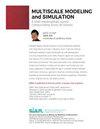具有长程相关的随机分层介质中波前的有效分数阶傍轴波动方程
IF 1.6
4区 数学
Q2 MATHEMATICS, INTERDISCIPLINARY APPLICATIONS
引用次数: 1
摘要
这项工作涉及高频波在随机分层介质中传播的渐近分析,具有快速变化和远程相关性。分析发生在三维物理空间和弱耦合状态下。在传播脉冲中,相关性的缓慢衰减所起的作用是双重的。首先,我们观察到一个以分数布朗运动为特征的随机旅行时间,其标准差似乎大于脉冲宽度,这与具有混合特性的随机传播介质的标准O 'Doherty-Anstey理论相反。其次,将确定性脉冲变形描述为包含伪微分算子的近轴波动方程的解。该算子的特征是介质波动的自相关函数。在具有长期相关性的波动情况下,该算子接近于分数阶Weyl导数,其阶数在2和3之间,取决于自相关函数的幂衰减。在频域,伪微分算子表现出频率相关的幂律衰减,其指数对应于分数阶导数的阶数,以及频率相关的相位调制,两者都确保了极限傍轴波方程的因果关系以及Kramers-Kronig关系。对具有长程相关的随机常微分方程,利用近似扩散定理进行了数学分析。本文章由计算机程序翻译,如有差异,请以英文原文为准。
An Effective Fractional Paraxial Wave Equation for Wave-Fronts in Randomly Layered Media with Long-Range Correlations
This work concerns the asymptotic analysis of high-frequency wave propagation in randomly layered media with fast variations and long-range correlations. The analysis takes place in the three-dimensional physical space and weak-coupling regime. The role played by the slow decay of the correlations on a propagating pulse is twofold. First we observe a random travel time characterized by a fractional Brownian motion that appears to have a standard deviation larger than the pulse width, which is in contrast with the standard O’Doherty–Anstey theory for random propagation media with mixing properties. Second, a deterministic pulse deformation is described as the solution of a paraxial wave equation involving a pseudodifferential operator. This operator is characterized by the autocorrelation function of the medium fluctuations. In case of fluctuations with long-range correlations this operator is close to a fractional Weyl derivative whose order, between 2 and 3, depends on the power decay of the autocorrelation function. In the frequency domain, the pseudodifferential operator exhibits a frequency-dependent power-law attenuation with exponent corresponding to the order of the fractional derivative, and a frequency-dependent phase modulation, both ensuring the causality of the limiting paraxial wave equation as well as the Kramers–Kronig relations. The mathematical analysis is based on an approximation-diffusion theorem for random ordinary differential equations with long-range correlations.
求助全文
通过发布文献求助,成功后即可免费获取论文全文。
去求助
来源期刊

Multiscale Modeling & Simulation
数学-数学跨学科应用
CiteScore
2.80
自引率
6.20%
发文量
45
审稿时长
6-12 weeks
期刊介绍:
Centered around multiscale phenomena, Multiscale Modeling and Simulation (MMS) is an interdisciplinary journal focusing on the fundamental modeling and computational principles underlying various multiscale methods.
By its nature, multiscale modeling is highly interdisciplinary, with developments occurring independently across fields. A broad range of scientific and engineering problems involve multiple scales. Traditional monoscale approaches have proven to be inadequate, even with the largest supercomputers, because of the range of scales and the prohibitively large number of variables involved. Thus, there is a growing need to develop systematic modeling and simulation approaches for multiscale problems. MMS will provide a single broad, authoritative source for results in this area.
 求助内容:
求助内容: 应助结果提醒方式:
应助结果提醒方式:


